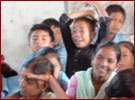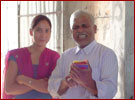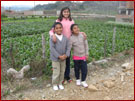
|
|
Health and Nepal Health-care problems were varied and enormous. Health and health-care facilities were generally poor and directly reflected the mode of life. The majority of people lived in mass poverty and deprivation, while the nation's small wealth was concentrated in the hands of a few. Deprivation was apparent in the pervasiveness of poor nutrition and sanitation, inadequate housing for most families, and the general absence of modern medical care and other social services, especially in rural areas. The rich lived comparatively well but also shared such common problems as the lack of an abundant and clean water supply, and the prevalence of disease. Diseases and Disease Control A number of diseases and chronic infections were prevalent. Goiter, a disease directly associated with iodine deficiency, was endemic in certain villages in the hills and mountains. In most of the villages surveyed, more than half of the population had goiter, and in these same villages the incidence of deafness and mental retardation was much higher than in other villages. Leprosy also was a serious problem. Foreign assistance, specifically through Christian missions, was responsible for setting up leprosy treatment centers in different parts of the country. Tuberculosis has been a chronic problem and was more common in urban areas. During the 1970s, the Tuberculosis Control Project was established to provide immunizations to all children younger than fifteen, and it is likely that this project has reduced tuberculosis. Other chronic, widespread problems were intestinal parasites, diarrhea, and gastrointestinal disorders. Some polio and typhoid infections were common but not severe. Malnutrition was a chronic problem, especially in rural areas. More than 50 percent of the children surveyed were reported to have stunted growth. "Wasting," defined as a condition in which a child has very low weight for his or her height, was also evident. These conditions were particularly bad in the Hill and Mountain regions, both of which suffered from food shortages. The country's public health program, however, has essentially eliminated smallpox and has been able to control malaria, which used to be endemic to the Tarai Region and other lowlands. Health-Care Facilities Popular folk medicine derived from a large body of commonly held assumptions about magical and supernatural causes of illness. Sickness and death often were attributed to ghosts, demons, and evil spirits, or they were thought to result from the evil eye, planetary influences, or the displeasures of ancestors. Many precautions against these dangers were taken, including the wearing of charms or certain ornaments, the avoidance of certain foods and sights, and the propitiation of ghosts and gods with sacrificial gifts. When illness struck or an epidemic threatened, people went to see a jhankri for treatment. Such pseudomedical practices were ubiquitous; in many parts of Nepal, a jhankri was the only source of medical care available. Nepalese also regularly saw jotishi (Brahman astrologers) for counseling because they believed in planetary influence on their lives, resulting from disalignments of certain planetary signs. Jotishi were commonly relied on even in urban areas, and even by those who were well educated and frequently used modern medicine. And, virtually no arranged marital union was proposed and concluded without first consulting a jotishi. The Ayurvedic system of medicine was believed to have evolved among the Hindus about 2,000 years ago. It originally was based on the Ayur-Veda (the Veda of Long Life), but a vast literature since has accumulated around this original text. According to the Ayurvedic theory, the body, like the universe, consists of three forces--phlegm, bile, and wind--and physical and spiritual wellbeing rests on maintaining the proper balance among these three internal forces. A harmonious existence between body and mind results. Ayurvedic pharmacopoeia--based on medicinal plants, plant roots, and herbs--remained a major source of medical treatment in Nepal. This school of medical practice also applies the hot-and- cold concept of foods and diets. In the late 1980s, there were nearly 280 practicing Ayurvedic physicians, popularly known as vaidhya, 145 Ayurvedic dispensaries, and a national college of Ayurvedic medicine in Kathmandu. In 1991 the most commonly used form of medical treatment, especially for major health problems, was modern medicine whenever and wherever accessible. Within the domain of modern medicine, providing public health-care facilities was largely the responsibility of the government. Private facilities also existed in various regions. Modern medical service generally was provided by trained doctors, paramedics, nurses, and other community health workers. The government-operated health-care delivery system consisted of hospitals and health centers, including health posts in rural areas. Hospitals were located mostly in urban areas and provided a much wider range of medical services than health centers. They were attended by doctors, as well as by nurses, and equipped with basic laboratory facilities. Small health centers and posts in rural areas--most of them staffed by paramedical personnel, health aides, and other minimally trained community health workers--served the needs of the scattered population. Even though these rural facilities were more accessible than urban hospitals, they generally failed to provide necessary services on a regular and consistent basis. The majority of them were barely functional because of such problems as inadequate funding; lack of trained staff; absenteeism; and chronic shortages of equipment, medicines, and vaccines. Nepal had a total of 123 hospitals, eighteen health centers, and 816 health posts in 1990. There was one hospital bed for every 4,283 persons, an improvement since 1977, when there was one hospital bed for every 6,489 persons. The number of doctors totaled 879 in 1988, or one physician available for about 20,000 people. For the same period, other medical personnel included 601 nurses, 2,062 assistant nurses and midwives, 2,790 senior and assistant auxiliary health workers and health assistants, and 6,808 villagebased health workers. There was no doubt in the late 1980s that considerable progress had been made in health care, but the available facilities were still inadequate to meet the growing medical needs of the population. The majority of people lacked easy access to modern medical centers, partly because of the absence of such facilities in nearby locations and partly because of the physical barrier posed by the country's rugged terrain. Because there were very few modern means of transportation in rural areas, particularly in the hills and mountains, people had to walk on average about half a day to get to health posts. Such a long walk was not only difficult (especially when the patient needed medical attention), but also meant economic hardship for the majority who rarely could afford to be absent for the whole day from their daily work. As a result, many minor illnesses went untreated, and some of them later developed into major illnesses. In the early 1990s, Nepal's geographical limitations continued to play a large part in the country's social and economic problems. Moreover, despite twenty-five years of family planning programs, the population growth rate continued to outpace agricultural production and parts of the country continued to be food deficit areas. The educational base was also limited; only one-third of the population was literate. The generally poor health of the population and a lack of adequate health-care facilities also hindered social and economic improvements. For this article we are indebted to
|




